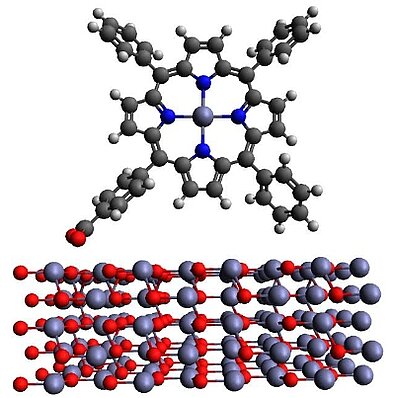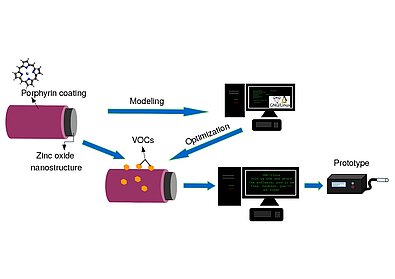Project title:
"Development of ZnO/porphyrin nanocomposites for optical nanosensors for determination of volatile organic compounds"
Project contract number:
1.1.1.2/VIAA/3/19/490
Project implementation deadline:
36 months (01.05.2020. - 30.04.2023.)
Total project funding:
133 805,88 EUR
Research manager:
Ulises Miranda Ordonez (Laboratory of Optical biosensors and functional nanomaterials)
Aim of the project:
Development new optical sensor elements based on ZnO-porphyrin for the detection of volatile organic compounds, such as aromatic and organic acids, in nanostructures. The main goal of the project is to adjust the sensitive and selective properties of the composite by optimizing the selective porphyrin layer (non-metallic and metal-containing porphyrins). Theoretical analysis of nanocomposite structure, electronic, optical properties, interaction of Zn-porphyrin and Zn-porphyrin target molecule will be performed using density functional theory and computational modeling. ZnO nanostructures will be synthesized by chemical bath deposition and electrospinning method. Porphyrin coatings will be deposited by the dip coating method. The structural, electronic and optical properties of the composite will be studied by XRD, FTIR, Raman, SEM, TEM and optical spectroscopy methods. The sensitivity and selectivity of the new composite materials to the target gas molecules will be studied by absorption, reflection and photoluminescence methods at room temperature. The expected results will test the mechanisms of nanocomposite surface / target-gas molecule interactions, sensitivity and selectivity adjustment methods, and two prototypes of optical gas sensor elements for target molecule detection.


Project results, etc. information on project implementation:
1: Computer modeling and theoretical research of ZnO / porphyrin nanocomposites.
Goals:
- To analyze the surface interaction between ZnO and porphyrins, as well as between ZnO / porphyrin and the target VOC.
- Analyze and propose adapted structural, electronic, optical and sensory properties of ZnO / porphyrins against target VOC molecules.
- To determine the parameters that improve the sensitivity properties of ZnO / porphyrin nanocomposites to the target VOC cluster.
Results:
- Analysis of optimized structures, adapted structural (geometrical parameters, crystal structures) and optoelectronic properties of ZnO / porphyrin nanocomposites (state density, band gap, electron population, absorption coefficient).
2: Synthesis, structural and optical characterization of ZnO / porphyrin nanocomposites.
Goals:
- Synthesize different ZnO nanostructures (nanoparticles, nanoparticles, etc.).
- To function ZnO nanostructures with porphyrin layers of different thickness.
- To study the structural and electronic properties of new photonic nanomaterials.
- To study the optical properties of new photonic nanomaterials.
Results:
- ZnO / Porphyrin nanocomposites with adapted structural elements (crystal structure, grain size, etc.), optoelectronic properties (binding energy, phonon peaks, redox peaks, absorption and emission bands, band gap, Urbach tail energy);
- Mechanisms to adapt basic properties and photoinduced processes to ZnO / porphyrin nanocomposites.
3: Investigation of the sensitive properties of ZnO / porphyrin nanocomposites.
Goals:
- Investigate the sensitive properties of ZnO / porphyrin nanocomposites in the following VOCs: benzene, toluene, phenol, acetic acid and acetone using optical (diffuse reflection and absorption) and photoluminescence methods.
- Optimize the sensitive parameters of new photonic materials.
Results:
- Sensitivity, selectivity, limit of detection, reaction and recovery time of ZnO / Porphyrin nanocomposite optical gas sensors.
- Two prototypes of sensor devices.
4: Project management and dissemination of results.
Goals:
- Prepare all Project documentation (Periodic reports, etc.)
- To control and ensure the achievement of project results.
- Ensure effective decision-making in risky situations.
- Organize effective dissemination of project results to the scientific community, the general public, industry, stakeholders and end-users.
Results:
- Project documentation (upon request of the program).
- Project meetings. Weekly.
- Local reports. Every six months.
- Project reports. 18th and 36th month.
- 4 published articles, 3 conference papers. 36th month.
- Dissemination activities to the general public, industry, stakeholders and end - users. 36th month.

 Academic Centre
Academic Centre